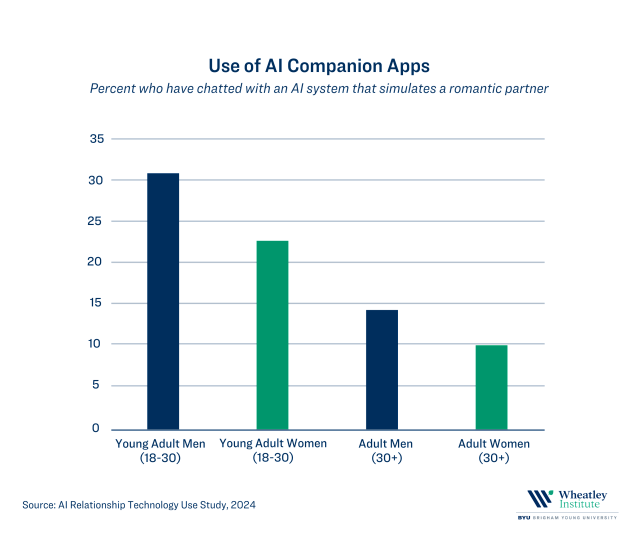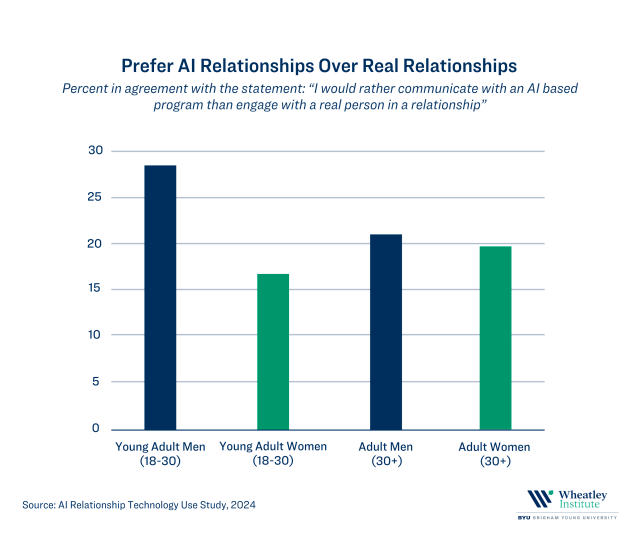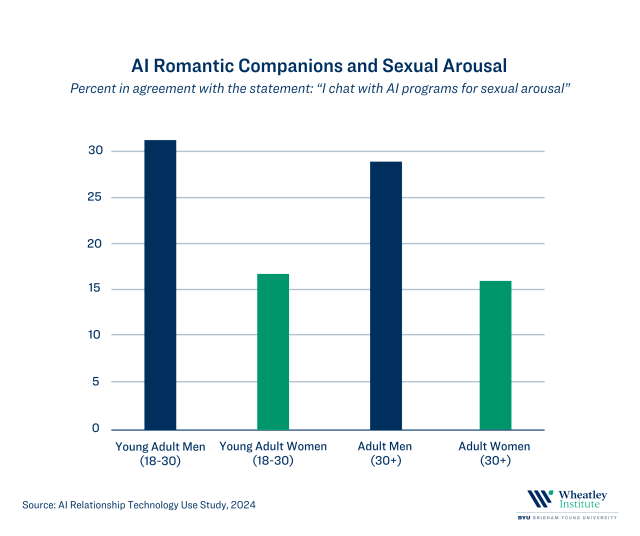Highlights
- A substantial proportion of users reported favorable attitudes toward AI relationships with 42% agreeing that AI programs are easier to talk to than real people. Post This
- Almost 1 in 5 of adults in the United States (19%) report having chatted with an AI system meant to simulate a romantic partner. Post This
- The use of AI companion apps and AI pornography are significantly linked to a higher risk of depression and higher reports of loneliness. Post This
The use of Artificial Intelligence (AI) has surged in recent years, with users of AI platforms now numbering in the billions around the globe. Despite this growth, little attention has been paid to how AI technologies may impact real human relationships. In particular, very little is known about how the emergence of AI relationship platforms that replicate romantic and sexual interactions may impact dating and marriage relationships, as well as the personal well-being of the users of these technologies. A deeper understanding of these trends is needed, as a recent IFS study recently found that 1 in 4 young adults think AI boyfriends and girlfriends could replace real-life romance.
In a new report from the Wheatley Institute, we present the findings of a new study designed to explore how common it is for adults in the United States to use three types of AI relationship technologies, namely: (1) Social media platforms displaying idealized and sexualized images of women and men, (2) AI romantic companion apps that simulate romantic and sexual partners, and (3) AI generated pornography consisting of computer-generated pictures and videos.
These technologies are becoming more numerous, with dozens of apps and websites advertising their services across all major online app stores and search engines, along with hundreds of social media accounts that generate idealized, and often sexualized, AI images that are now easily accessible to millions of potential users, including children.
AI Technology and Relationships
Public interest in AI technologies connected to romantic relationships is growing with recent estimates suggesting that current monthly online searches for AI romantic partners exceed 70,000, while downloads of AI companion apps have dramatically risen in recent years.
While these platforms can take many forms, they often utilize “generative AI” to create impromptu conversations that appear as though a human is creating them. Given that these platforms utilize AI learning technologies, these AI companions continue to evolve as users interact with them, developing relationship “personas,” which learn from users’ responses and can create increasingly sophisticated simulated emotional connections with their users by customizing their interactions to appeal to the users’ preferences and attractions.
These generative AI systems have typically been taught to be emotionally validating, caring, and always interested in what the user has to say, and, in many cases, to be overtly sexual. Many platforms intermix chat-based conversations with life-like, realistic, and sometimes sexually-explicit AI generated images for the fictional avatar. Many of these platforms allow individuals to “program” their ideal partners, creating idealized companions in terms of both facial features, body shape, dress and appearance, and personality traits. In some cases, users are allowed to generate images for their AI companion with body proportions that are unrealistic or depict an artistic style, such as anime.
How Many People Are Using AI Relationship Technologies?
Recently, we surveyed nearly 3,000 adults (age 18 and older) across the United States, with an oversample of 1,000 young adults (ages 18 to 30). Participants were screened based on a quota sampling framework to ensure specific percentage sampling pools across several key demographics to mirror national demographics in the United States, especially in terms of biological sex, age, and race/ethnicity. We examined use levels separately for men and women, as well as for young adults (18 to 30 years old) and older adults (30+ years of age).
These preliminary findings suggest that AI technologies represent an emerging and notable threat to users’ personal well-being and relationship health.
We found that viewing AI social media with idealized and sexualized images of men and women is relatively high, especially given the somewhat new nature of these technologies. More than half of study participants (53%) reported that they had viewed an AI social media account that generates these types of images.
In terms of regular or habitual engagement, nearly 1 in 4 of young adult men (24%) and 1 in 5 young adult women (18%) reported that they actively follow social media accounts that exclusively generate AI images of men and women. This is a rate that is approximately twice as high their adult peers (10% of adult men and 9% of adult women).
Engagement with romantic AI companion apps was even higher, with almost 1 in 5 of US adults (19%) reporting that they have chatted with an AI system meant to simulate a romantic partner. Again, use rates were particularly high among young adults, with nearly 1 in 3 young adult men (31%) and 1 in 4 young adult women (23%) reporting that they have chatted with an AI boyfriend or girlfriend. However, these technologies are increasingly becoming common among older adults as well, with 15% of adult men and 10% of adult women reporting that they have chatted with a virtual romantic companion.
However, young adults are still more than twice as likely to have interacted with a simulated romantic companion than their older peers. It is important to note that this question specifically asked about AI companion apps that simulate a romantic partner; the use rates are likely higher if all forms of AI companion interaction are included, such as interaction for friendship, companionship, and instruction.

For a notable portion of individuals, their interaction with AI companions goes beyond romantic conversations and becomes sexual in nature. In fact, 7% of overall study participants reported that they interact with AI romantic companions for sexual purposes. This behavior was a more common for men (14% of young adult men and 5% of adult men) than for women (7% of young adult women and 3% of adult women). However, young adult women were still slightly higher than adult men and more than twice as likely as adult women to report using AI romantic companions for sexual purposes, suggesting that a cohort effect is also influencing use trends.
This trend holds true for the use of AI generated pornography, too. In fact, young adult men are more than twice as likely to view AI pornography than young adult women (27% of young adult men vs. 12% of young adult women) and adult men are three times more likely to view AI pornography than adult women (12% of adult men vs. 4% of adult women). However, it is worth noting that young adult women are as equally likely as adult men to report that they have viewed AI pornography and are three times more likely to view such types of sexual media than their adult women peers (12% vs. 4%).
How Do Users Evaluate Their Use of AI Relationship Technologies?
In addition to assessing how many young adults and older adults are using AI relationship technologies, we also examined how users evaluate their experiences. Given the relatively high level of use we see with these technologies, we had a sizeable sample of AI engagers for this portion of the study (1,890 participants).
We found that AI relationship technologies often create a perceived sense of belonging and connection. Specifically, we found that among those who viewed idealized AI images of men and women, 13% said they prefer AI images over images of real people. Of those who chatted with AI systems to simulate romantic partners, over 1 in 5 (21%) agreed that they preferred AI communication over engaging with a real person. A substantial proportion of users reported favorable attitudes toward AI technologies, with 42% agreeing that AI programs are easier to talk to than real people, 43% believing that AI programs are better listeners, and 31% reporting that they feel that AI programs understand them better than real people.

These technologies are also frequently being utilized for sexual conversations and behaviors. Among those viewing AI images, about 1 in 8 reported viewing AI images for sexual arousal. A larger proportion of AI engagers (33%) noted that they chat with AI technologies for sexual arousal. When asked about the frequency of sexual conversations with AI companions, 26% reported engaging in such behavior at least once in the last year, but less than a few times per month. However, 1 in 6 AI users (16%) reported having at least a weekly sexual conversation with an AI simulated companion.
Using AI chats for the sexual arousal was even more common among men, with almost 1 in 3 of young adult men who use AI platforms (32%) reporting that they chat with AI for sexual arousal. These levels are nearly twice as high as women AI users who reported chatting with an AI companion for sexual arousal (17% of young adult users and 16% of adult women users).

How Do AI Relationship Technologies Impact Mental Health?
Despite promising to enhance real-life relationships through practicing social interaction, we found that the use of AI companion apps is strongly linked to a higher risk of depression and higher reported levels of loneliness. We believe that with more research we will find that, similar to pornography, these apps offer a momentary escape from emotional struggles but then leave the user feeling increased isolation – thus creating a familiar negative cycle that damages mental health and real relationship bonds.
For example, over half of men who use AI platforms for sexual or romantic purposes reported being at risk for depression using items from the Center for Epidemiologic Studies Depression Scale (CES-D), and over half reported high levels of loneliness. These rates were almost double the rates of men who did not utilize AI platforms. Women who used AI platforms seemed to be at particular risk for poor outcomes, with over 60% of women who used AI platforms reporting a risk for depression and over half (52%) reporting high levels of loneliness. Again, this was significantly higher than the risk of depression and reported loneliness among women who were not using AI relationship technologies.
Prioritizing True Human Connection
Overall, these preliminary findings suggest that AI technologies represent an emerging and notable threat to users’ personal well-being and relationship health. The fact that a notable portion of both young and older adults are already engaging regularly with these technologies speaks to their appeal and to the likely potential for unhealthy and compulsive use patterns. The rise of romantic AI companions and AI generated pornography is deeply troubling due to the risk these new technologies pose for increasing unrealistic relationship expectations and for deprioritizing real-life human relationships, as well as fueling existing trends of loneliness, declines in dating, and decreased family formation.
Brian J. Willoughby, Ph.D., is a Professor in the School of Family Life at Brigham Young University and a Fellow of the Wheatley Institute. Dr. Willoughby is considered an international expert in the fields of couple and marital relationships, sexuality, and emerging adult development.
Jason S. Carroll, Ph.D. is the Director of the Marriage and Family Initiative at the Wheatley Institute at Brigham Young University. He is also a Senior Fellow at the Institute for Family Studies. Dr. Carroll is a past recipient of the Berscheid-Hatfield Award for Distinguished Scientific Achievement given by the International Association for Relationship Research.













